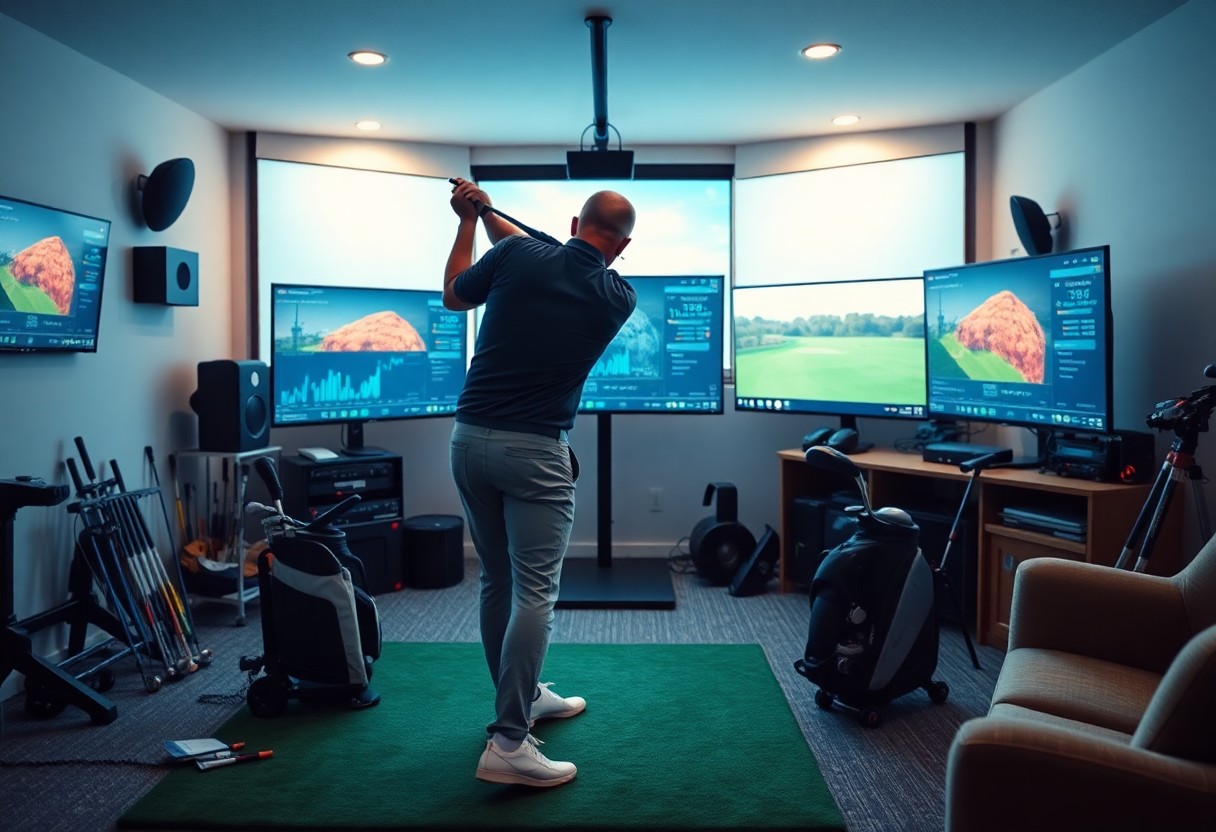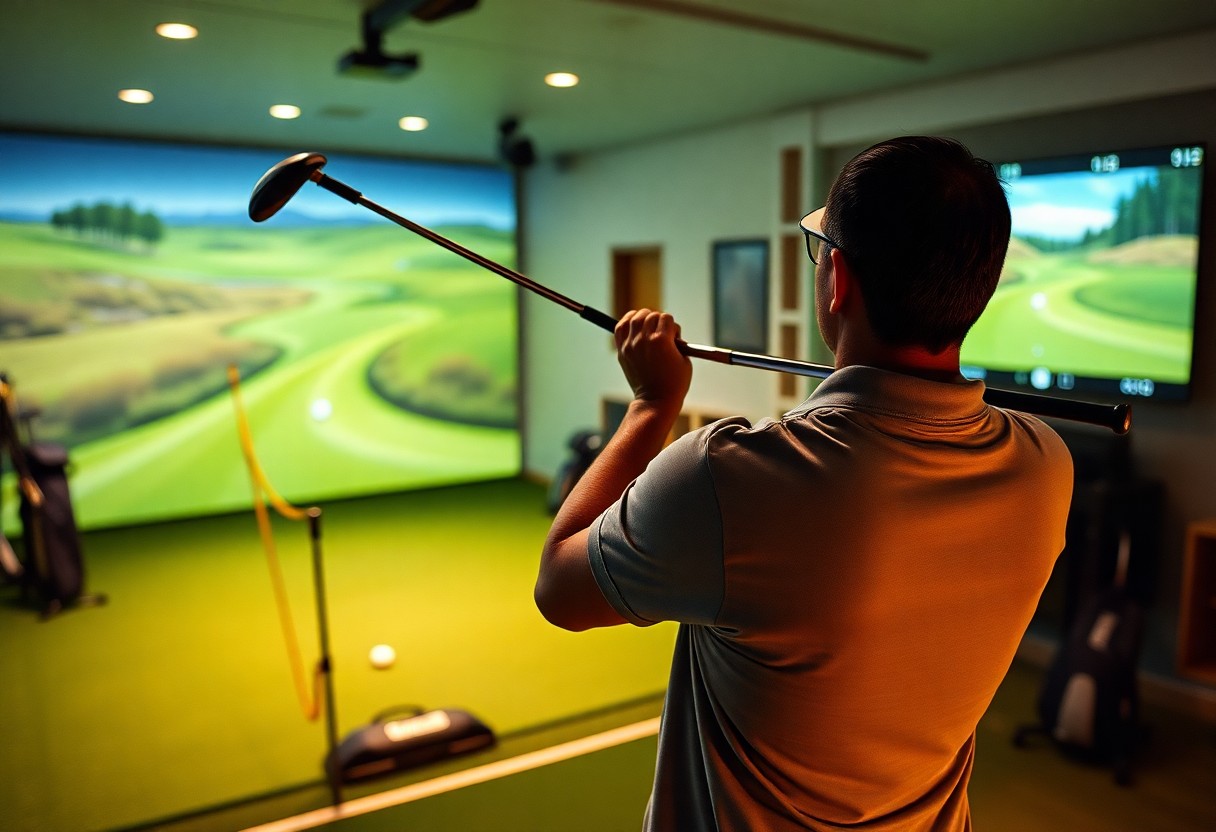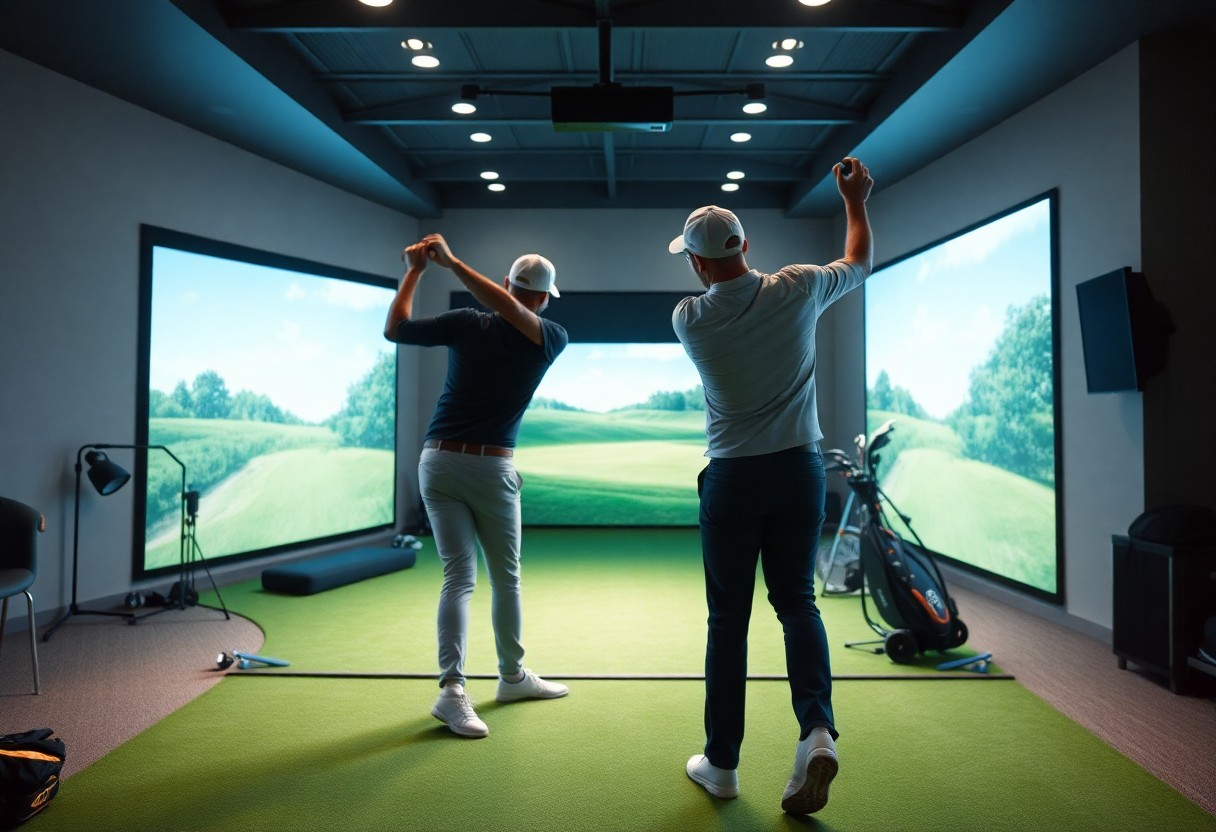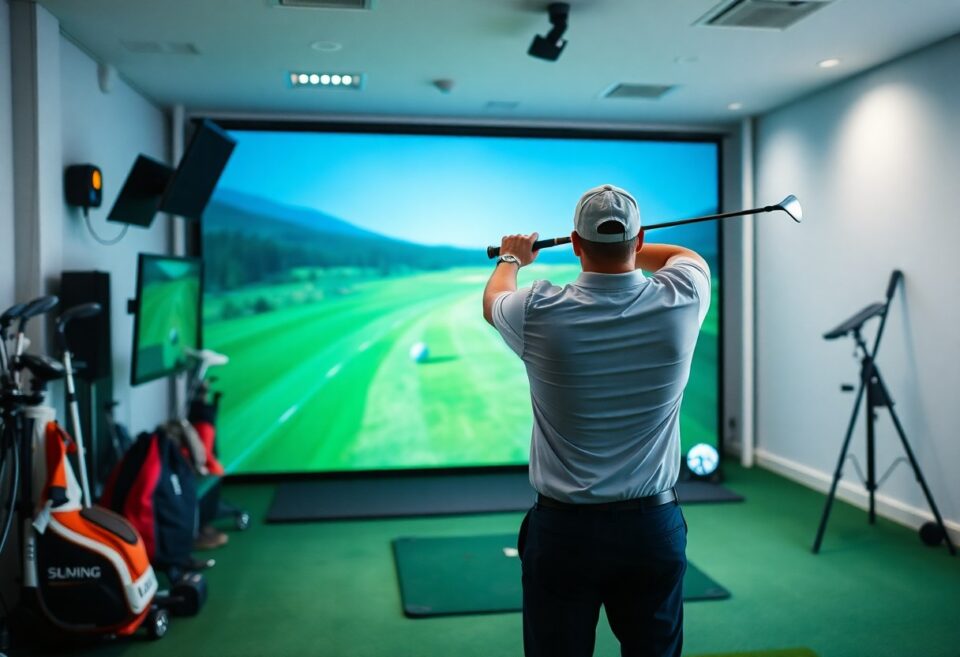Benefits of using a home golf trainer extend far beyond convenience, offering you a unique opportunity to refine your technique without external pressures or distractions. By practicing consistently in a controlled environment, you can analyze and improve your swing mechanics with precision, leading to significant enhancements in your game. Additionally, this approach minimizes the risk of injury by promoting safer, guided movements. As you engage daily, your understanding of biomechanics deepens, transforming practice into a scientifically informed routine that accelerates progress and maximizes enjoyment.

Transforming Practice: The Role of a Home Golf Trainer
Personalized Coaching at Your Fingertips
Incorporating a home golf trainer into your routine grants access to personalized coaching that adapts to your unique swing dynamics and skill level. Unlike traditional coaching sessions where instruction can be generalized or constrained by time and location, a home trainer offers tailored feedback with precision analytics. You can repeatedly practice shot adjustments based on biomechanical data, enabling you to isolate flaws in your grip, stance, or swing path. For instance, some advanced models employ AI-driven algorithms to compare your swings against elite golfer databases, highlighting subtle deviations that would otherwise escape the naked eye.
This level of detailed mentorship revolutionizes your ability to self-correct and optimize performance incrementally. By consistently working with your home trainer, you develop an intimate understanding of how minute changes affect ball trajectory and distance, which accelerates skill acquisition. The system’s capacity to calibrate drills specific to your needs—from improving drive accuracy to enhancing short game finesse—presents a bespoke learning environment that supplements any traditional coaching you receive. You effectively become your own coach, equipped with data precision and cognitive cues that inform every next move.
Moreover, the convenience of having personalized coaching available anytime eliminates the sporadic nature of conventional lessons. You can engage in focused sessions as your schedule permits, fostering habitual refinement rather than episodic practice. Perceiving these advantages situates a home golf trainer not merely as a gadget but as an crucial partner in your journey toward consistent, measurable improvement.
Feedback Mechanisms: Real-Time Data for Skill Enhancement
Feedback systems embedded in home golf trainers provide you with instantaneous insights that traditional range practice often lacks. Sensors track metrics such as swing speed, clubface angle, launch angle, and ball spin with remarkable accuracy, delivering numbers that give context to what you feel in real time. This immediate exchange of information means you can adjust your technique on the spot, closing the feedback loop within seconds rather than hours or days. Studies demonstrate that golfers incorporating real-time feedback improve shot consistency by up to 25%, a testament to the efficacy of this technology.
The rich data output transforms abstract sensations into quantifiable moments of success or areas for growth. Visual displays and intuitive interfaces allow you to visualize performance trends across multiple sessions, facilitating a deeper understanding of your mechanics. Such clarity is particularly beneficial when refining complex movements—like synchronizing hip rotation with wrist release—where milliseconds and millimeters determine shot outcomes. Your capacity to internalize these adjustments is enhanced dramatically as you engage repeatedly with accurate, objective metrics.
Various models offer customizable alert systems that notify you when swing parameters deviate from ideal ranges. This ongoing, precise feedback serves as an immediate corrective guide, reducing the habitual reinforcement of flawed techniques. Perceiving the impact of these features demonstrates how a home golf trainer can serve as a catalyst for accelerated learning, amplifying your time investment into meaningful advancement.
Expanding beyond real-time numerical data, some advanced home golf trainers integrate video playback synchronized with sensor analytics, allowing you to visualize your swing frame-by-frame alongside quantitative feedback. This dual modality fosters a comprehensive learning experience by engaging both visual and analytical processing. For example, seeing a discrepancy in clubhead speed coupled with slow-motion footage of your swing facilitates a more holistic understanding, empowering you to make precise corrections that enhance your overall golfing technique.

Maximizing Efficiency: Time-Saving Benefits of Home Training
Eliminating Travel Time: More Hours on the Green
One of the most tangible benefits of having a home golf trainer is the elimination of travel time to and from golf courses or driving ranges. This can save you an average of 30 to 60 minutes per practice session, which accumulates significantly over weeks and months. Instead of allocating a large chunk of your day just to commute, you can immediately transition into focused practice as soon as your schedule allows.
Consider that busy professionals often report struggling to find enough hours to dedicate to golf due to commutes and facility hours. With your home golf trainer, you bypass this limitation entirely. The time saved is not simply about convenience—it translates into more consistent practice, inviting more frequent touchpoints to refine your swing mechanics or experiment with techniques. This increase in practice frequency directly correlates with improved skills and confidence on the course.
Furthermore, reduced travel also means less exhaustion and mental fatigue. Driving to a golf facility, dealing with weather uncertainties during commutes, or navigating crowded practice spots can sap your energy before you even start swinging. Practicing at home keeps you physically fresh and mentally focused, allowing you to extract the maximal value from every practice minute. The simple act of cutting out travel may well elevate your entire golfing experience.
Flexible Scheduling: Practice Whenever, Wherever
When practice is no longer confined by facility hours or daylight conditions, you gain complete control over scheduling your sessions. This flexibility means you can intuitively align golf practice with your natural energy cycles and other daily commitments, whether it’s early morning, late evening, or even during breaks throughout the day. No longer tethered to rigid practice windows, you are free to maximize how and when you engage with your training.
The ability to fit in short, focused sessions at your convenience can yield remarkable improvements over time. For instance, instead of waiting for a single long practice block on weekends, you might take five or ten minutes in the morning to work on your putting stroke or spend a few minutes after work perfecting your swing path. Such distributed practice sessions are supported by motor learning research, which shows that shorter, regular practice often leads to better skill retention and gradual improvements.
This kind of autonomous scheduling also allows you to adapt quickly to your fluctuating motivation and physical condition, practicing intensively when you feel energized and scaling back during periods of fatigue. The newfound freedom to coordinate your practice seamlessly with daily life reduces stress and makes developing your golf game an engaging and enjoyable routine rather than an intrusive obligation.
Beyond just freeing your schedule, flexible home training means your practice space is wherever you set it up—be it a dedicated garage bay, a backyard putting green, or a spare room outfitted with tracking sensors. This locality independence not only saves time but also provides a controlled environment where you can consistently practice specific elements of your game without external distractions or interruptions common at public ranges.
Cost-Benefit Analysis: Financial Implications of Home Golf Training
Long-Term Savings Compared to Traditional Lessons
Your decision to invest in a home golf trainer can yield substantial financial advantages over the long term when compared to conventional golf lessons. Traditional coaching often requires recurring expenses, with lesson packages ranging from $50 to $150 per session. Over the course of a year, weekly lessons could easily accumulate to over $2,500. By contrast, a one-time investment in a high-quality home golf trainer—typically priced between $500 and $2,000—eliminates these ongoing fees. You not only save on the cumulative cost of lessons but also maintain full control over the pace and frequency of your practice without additional charges.
Moreover, the home trainer allows for continuous, self-directed refinement of your skills, which can lead to a higher skill acquisition rate. Enhanced feedback systems embedded in many devices can analyze golf swing metrics such as tempo, angle, and ball trajectory with precision, providing data comparable to what you’d receive in professional lessons. This continual evaluation enables improvements that might otherwise necessitate multiple coaching sessions, thus enhancing the financial efficiency of your training.
To illustrate these savings clearly, consider the following comparison: assuming you take a lesson weekly for a year at an average cost of $75, your total expense would be $3,900. In contrast, acquiring a home golf trainer at $1,200 could cover your training needs for years, paying for itself in less than 6 months of equivalent weekly lessons. This paradigm shift from recurrent spending to a single upfront cost represents a pronounced economic advantage for those committed to long-term improvement.
| Traditional Lessons | Home Golf Trainer |
|---|---|
| $75 per lesson × 52 weeks = $3,900 annually | One-time cost between $500 – $2,000 |
| Variable scheduling and availability of instructors | Practice anytime without scheduling constraints |
| Ongoing financial commitment year after year | Single investment with potential lifetime usability |
Investment in Equipment vs. Course Fees and Travel Costs
Course fees and travel expenses can rapidly inflate the total cost of traditional golf training. Daily green fees range from $40 to $100 depending on the course and location, and frequent visits add up quickly. Additionally, if you travel to access high-quality courses or specialized instructors, transportation and lodging costs can increase your spending by hundreds or thousands annually. In contrast, once you acquire a home golf trainer, you circumvent these variable and often unpredictable expenditures entirely.
When you analyze the economics of regular golfing at established courses, transportation costs—including fuel, parking, or public transport—become a non-negligible factor. If your closest proficient instructor or preferred course is 30 miles away, a round trip could cost $15 or more every session just for travel. Factor in time lost, and the investment in home equipment feels increasingly justified by both monetary and temporal savings.
The multifaceted nature of these expenses often means you pay not only for training but also ancillary costs that contribute to the overall financial burden of conventional golf practice. Your home trainer liberates you from these supplemental encumbrances. Equipment costs are predictable and finite, providing clarity and peace of mind, while conventional golf costs remain variable and tend to increase with frequency and geographic location.
In essence, access to home golf training technology substitutes an array of fluctuating and hidden costs with a single, manageable expenditure. This substitution enables you to allocate more resources towards the quality of your training rather than ancillary expenses, promoting a more effective and financially sustainable approach to elevating your golf skills.

Bridging Technology and Tradition: The Innovative Tools of Home Golf Training
The landscape of home golf training has been transformed by the fusion of traditional techniques with cutting-edge technology. At the heart of this evolution lies a suite of innovative tools that enable you to refine your skills with remarkable precision and immediacy. These advancements do not merely replicate the golf course experience; they augment your understanding of the game’s mechanics through real-time data and immersive environments. Devices integrated with motion sensors meticulously track your swing metrics—clubhead speed, swing path, and impact angle—offering you insights that were once accessible only to elite athletes under the scrutiny of professional coaches.
Such innovations extend the boundaries of practice beyond physical repetitions by embedding analytical rigor into your routine. Every shot you take at home can be dissected for subtle errors or inefficiencies, allowing targeted adjustments that accelerate learning curves. This confluence of data-driven feedback and traditional muscle memory development creates a feedback loop where each session enhances cognitive and motor skills synergistically. As a result, your training becomes a sophisticated experiment in iterative self-improvement, where hypotheses about technique can be rapidly tested and refined in your personal environment.
More than just tools, these hybrid systems foster an intellectual engagement with golf as a complex physical science. They invite you to approach your practice like a researcher, formulating strategies based on quantifiable variables rather than relying solely on subjective feel. This paradigm shift represents a profound benefit; it empowers consistent progress and cultivates a deeper comprehension of the biomechanics and physics governing your performance on the fairway and greens.
Virtual Simulators and Analysis Software: A Game Changer
Virtual simulators equipped with advanced analysis software revolutionize your access to golf courses around the world, delivering hyper-realistic experiences within the confines of your home. These platforms use high-speed cameras, infrared sensors, and sophisticated algorithms to capture and analyze your swing dynamics with microscopic accuracy. You can practice on digital reproductions of legendary courses like St Andrews or Pebble Beach, challenging your skills in a variety of terrains without leaving your living room. This capability dramatically expands your tactical acumen, as each course requires different shot selections, club choices, and strategic thinking.
The software’s feedback mechanisms offer immediate, actionable insights by quantifying key performance indicators such as ball spin, launch angle, and carry distance. Integrating AI-driven coaching aids, these systems simulate professional instruction by suggesting corrections tailored to your unique swing characteristics. For example, if your data reveals a consistent slice, the system can recommend exercises to adjust your grip or stance. By substituting guesswork with empirical evidence, these digital tools refine your technique through evidence-based approaches that enhance efficacy and reduce the risk of ingraining bad habits.
Moreover, the customizable nature of virtual simulators lets you calibrate difficulty levels and practice conditions to fit your personal progression. Whether you’re rebuilding your swing after injury or preparing for a competitive round, such adaptability ensures that your training remains engaging and challenging. The immersive nature of the experience—the interplay of realistic graphics, sound effects, and responsive ball physics—maintains your focus and motivation, making prolonged practice sessions both productive and enjoyable.
Gamification of Learning: Keeping Motivation High
Incorporating gamification elements into your home golf training transforms what might otherwise be repetitive drills into dynamic challenges that stimulate sustained engagement. Leaderboards, achievement badges, and timed competitions inject a sense of friendly rivalry and accomplishment, crucial for maintaining enthusiasm over extended periods. These game-like incentives exploit your intrinsic desire for mastery and recognition, which propels continuous practice with an energy that mirrors real-world competition.
The integration of immersive challenges, such as virtual tournaments or skill-based minigames, scaffolds your development by gradually increasing complexity and requiring nuanced strategy adjustments. For instance, a putt accuracy challenge adapting to simulated wind conditions not only enhances technical skill but also develops your capacity to adapt dynamically to environmental stressors seen on actual courses. This multifaceted approach to training heightens cognitive engagement, ensuring that muscle memory does not develop in isolation but in concert with situational awareness.
Quantifying your progress through performance metrics embedded within gamified platforms gives you immediate validation of improvement and highlights areas for refinement, creating a feedback loop that fosters deliberate practice. By merging the analytical rigor of advanced technology with the motivational psychology of game design, these tools cultivate both discipline and joy within your training regimen.
To explore deeper, many home golf trainers now incorporate social connectivity features that enable you to compete or collaborate with fellow golfers globally. This networked dimension adds a layer of accountability and community, amplifying motivation and enriching your learning journey beyond solitary practice. By transforming your training into an interactive experience, the gamification of golf makes progression tangible and enjoyable, sustaining your commitment and passion for the game over time.
The Psychological Edge: Building Confidence and Reducing Performance Anxiety
Diving into your golf practice with a Home Golf Trainer grants you more than just physical skill enhancement; it ushers in a profound psychological transformation. Regular practice within your personal space eliminates the layers of social scrutiny and competitive pressure that often accompany on-course play, allowing your mind to focus purely on refining technique and cultivating positive self-talk. This unshackling from external judgment helps in rewiring negative thought patterns, converting moments of doubt into firm confidence. As neural pathways are strengthened through repetitive, focused drills, you begin to internalize a belief system grounded in consistent improvement rather than fear of failure.
Studies in sports psychology reveal that performance anxiety directly correlates with heightened muscle tension and disrupted concentration, leading to erratic swings and poor shot selection. The low-stakes environment of a home trainer combats this by providing immediate, repetitive feedback without the unpredictable pressures of a live round. Over time, your cognitive responses adapt, reducing cortisol spikes associated with stress and allowing for smoother, more fluid movements. This physiological calmness fosters better decision-making and shot execution, enhancing your resilience not only in practice but on the course as well.
Moreover, the Home Golf Trainer empowers you to construct mental rituals and pre-shot routines that become ingrained through daily use. These rituals serve as psychological anchors, guiding you from anxious uncertainties toward a state of relaxed focus. The ability to practice these elements systematically deepens your proficiency in managing internal states during critical moments, effectively lowering performance anxiety. This cumulative psychological advantage transforms not only your practice sessions but also crystallizes into tangible confidence gains during tournament play or casual rounds with friends.
Safe Spaces for Experimentation and Mistake-Making
Your home transforms into a laboratory for exploration where the consequences of trial and error are dramatically softened. The Home Golf Trainer invites you to venture beyond conventional techniques without the looming threat of embarrassment or lost strokes on the course. This safe context nurtures an experimental mindset, encouraging you to tweak swing mechanics, vary grip pressures, or test novel shot shapes freely. Each adjustment, regardless of immediate success, contributes valuable sensory feedback and deepens your understanding of biomechanics and ball flight physics.
In structured practice sessions at home, the opportunity to make repeated mistakes under controlled conditions accelerates learning through enhanced error recognition. Unlike on-course rounds where frustration and self-recrimination might take over, your home environment supports patience and curiosity. For example, if a slice continues to plague your drives, utilizing your trainer to experiment with clubface angles or stance alignment repeatedly allows you to isolate the root cause without performance penalties. Psychologically, this approach lowers the fear of failure, which often inhibits risk-taking and creative problem-solving in sport.
The freedom to fail safely builds resilience and mental toughness. You develop an awareness that errors are not definitive judgments on your ability but necessary data points in a broader learning trajectory. Over time, this mindset translates into greater composure during real-round adversity—sudden gusts of wind or errant shots become challenges to analyze rather than catastrophes. Your habitual exposure to constructive mistakes at home conditions your neural and emotional responses to approach setbacks with equanimity and determination.
Visualization Techniques Integrated into Home Routines
Integrating visualization exercises into your Home Golf Trainer sessions magnifies your psychological advantages by tapping into the brain’s inherent capacity to simulate performance. By mentally rehearsing precise swings and ideal ball trajectories while physically engaged with your trainer, your sensory systems synchronize imagined and actual experiences. Neuroscientific research demonstrates that such mental practice activates mirror neurons and motor cortex regions, thereby improving muscle memory and shot execution even without ball contact.
Visualization becomes particularly potent when coupled with the tactile feedback from your home setup. As you watch the alignment aids and simulate ball paths repeatedly, the clarity of mental imagery sharpens. This dynamic interplay fortifies neural circuits associated with spatial awareness and kinaesthetic sense. Golfers who incorporate guided imagery into their routine report increases in shot consistency, confidence under pressure, and quicker recovery from mistakes. For instance, cycling through visualizations of a perfect draw or a delicate chip shot conditions your brain to not only expect success but automatically adjust motor patterns to achieve it.
Moreover, your personalized environment facilitates the layering of complex scenarios within visualization sessions, from imagining varied course conditions to sequencing shots strategically. This process transcends rote repetition, engaging your cognitive faculties deeply and preparing your mind for nuanced in-game decisions. The Home Golf Trainer thus evolves into a mental gym where the boundary between practice and performance blurs, making mental rehearsal a tangible, integrated component of your skill-building arsenal.
Embedding visualization techniques into your home training routine not only accelerates neural adaptation but also bridges the gap between physical execution and mental preparedness. Through consistent mental simulation alongside active practice, you effectively enhance your brain’s predictive modeling of shots, reducing reaction times and improving accuracy during actual play. With each visualization, you lay down layers of cognitive encoding that eventually manifest as instinctive, fluid movements on the course, providing a subtle yet significant psychological edge.
To wrap up
Summing up, engaging with a home golf trainer offers you an unparalleled opportunity to deepen your understanding of the game, much like exploring complex theories in science. By practicing in the comfort of your own space, you create a controlled environment where you can experiment with different techniques and immediately observe outcomes. This iterative process mirrors the scientific method, allowing you to refine your skills through continuous feedback and adjustment, ultimately enhancing your performance on the course.
Moreover, the consistent use of a home golf trainer fosters a discipline that transcends mere physical activity; it encourages a mindset of analytical thinking and problem-solving. Just as you would systematically test a hypothesis, you can break down each aspect of your swing or stance, making precise adjustments informed by real-time data. This methodical approach not only improves your technical proficiency but also cultivates a deeper appreciation for the mechanics and physics underlying the sport, enriching your overall experience.
Finally, the convenience and accessibility of a home golf trainer empower you to integrate practice seamlessly into your daily routine, removing barriers that often impede progress. This accessibility invites you to engage with the game more frequently and with greater enthusiasm, promoting long-term commitment and enjoyment. In embracing this tool, you harness both scientific insight and personal dedication, propelling your golf journey forward with a blend of curiosity, precision, and passion.
FAQ
Q: How does using a home golf trainer improve my swing technique?
A: A home golf trainer provides immediate feedback on your swing mechanics, allowing you to analyze and correct your form consistently. This helps build muscle memory and promotes more accurate and powerful swings over time.
Q: Can playing golf with a home golf trainer help me practice more regularly?
A: Yes, having a home golf trainer allows you to practice anytime regardless of weather or schedule constraints. This convenience leads to more frequent practice sessions, which can significantly accelerate skill development.
Q: What types of skills can I enhance by using a home golf trainer?
A: A home golf trainer can help you improve various skills including swing tempo, accuracy, consistency, putting, and chipping. Many trainers also offer drills that target specific aspects of your game for a well-rounded improvement.
Q: Is a home golf trainer suitable for golfers of all skill levels?
A: Absolutely. Home golf trainers are designed to accommodate beginners through advanced players. They provide adjustable features and varied difficulty levels to challenge and support the development of any golfer.
Q: How can a home golf trainer help reduce the risk of injury?
A: Using a home golf trainer encourages proper form and swing mechanics, which can prevent strain and injuries associated with repetitive incorrect movements. It also allows for a controlled practice environment where gradual progression is possible.
Q: What are the cost-saving benefits of using a home golf trainer?
A: Investing in a home golf trainer can save money on lessons and driving range fees in the long run. It also reduces travel time and allows you to practice at home, making training more efficient and budget-friendly.
Q: How does practicing with a home golf trainer affect my confidence on the golf course?
A: Consistent practice with a home golf trainer builds familiarity and comfort with your swing and techniques. This increased competence boosts confidence, helping you perform better during actual rounds of golf.
